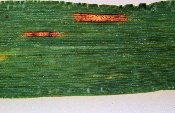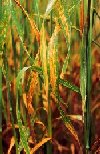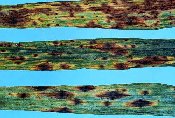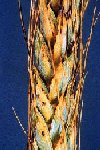| |
Septoria Complex, Speckled Leaf Blotch, Glume Blotch | |
| |
|
|
| |
|
|
| | Biology | Damage description | Diagnosis | Management strategy
Leptosphaeria avenaria f. sp. triticea (asexual Septoria avenae f. sp. triticea) Leptosphaeria nodorum (asexual Septoria nodorum)
Biology
This group of diseases is known as Septoria complex because they all may be present in the same field and even on the same plant. The Septoria complex of diseases occurs mainly on wheat, but is common on barley, oats, rye and grasses, especially Poa and Agrostis spp. They are widespread throughout the Prairie Provinces.
The fungi overwinter on seeds (S. nodorum mainly) and on stubble, straw and leaves of winter wheat. Spores infect the new crop during wet weather. Secondary infection to nearby plants results from spores produced on infected leaf spots transported by splashing rain and wind.
Wet windy weather favours this disease, while dry conditions reduce or prevent new infections and spore production on diseased plants. Plants must remain wet for six hours or more for successful spore infection. Increases in the incidence of this disease are related to denser, more humid foliage that occurs with higher nitrogen inputs.
Damage Description
The disease develops on all above-ground plant parts. Yellow flecks generally appear first on lower leaves.
Infections, which are initially water soaked, will become dry, yellow and finally red-brown. Tiny black pepper-like dots (reproductive structures called pycnidia) may appear in the infected areas. L. nodorum most often causes blotches on the glumes and stem nodes rather than on the leaves. Infections begin at the glume tips and work downward and form purplish areas that later produce the dark, characteristic pycnidia.
Diagnosis
Lesions on the important upper leaves and glumes critically reduce photosynthetic activity and can severely depress yields. Seed set is not harmed but seed filling is impaired and shrivelled grain may be lost with the chaff at harvest.
Management Strategy
- Use a crop rotation with non-cereal crops.
- Avoid planting seed containing a large amount of infected kernels.
- Although turning under the infected stubble and crop residue with tillage reduces disease incidence and controls disease in volunteer wheat seedlings, conservation tillage to preserve soil moisture is considered more important than the risk of early disease development.
- Use seed grown in the drier areas of the province that may be free of this disease or very low in seed-borne infection.
- Use wide row spacing and adequate, but not excessive, nitrogen levels. These practices lower canopy density and humidity, which would otherwise favour infection.
- Use resistant cultivars.
- Application of a fungicide to protect the flag leaf of the crop is effective depending on grain prices, seriousness of the disease and the cost of fungicide application.

Septoria (speckled leaf blotch) of barley.

Septoria leaf blotch of wheat (speckled leaf blotch).

Leaf blotch of oats caused by Septoria avenae.

Septoria glume blotch on wheat (Septoria nodorum).
Text and captions courtesy of Dr. Ieuan R. Evans
Images courtesy of I. R. Evans and WCPD |
|
| |
|
|
| |
For more information about the content of this document, contact Neil Whatley.
This document is maintained by Mary Ann Nelson.
This information published to the web on November 16, 2001.
Last Reviewed/Revised on November 23, 2017.
|
|